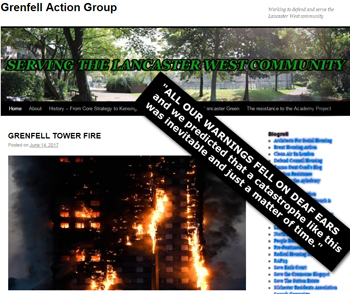As the second part of the Grenfell Fire Enquiry got underway this week, it emerged that the manufacturers of the cladding used on the Grenfell Tower “refurbishment” had been fully aware of problems with the building material, despite their denials of any responsibility for the deaths of 72 residents of the block; made by them yesterday.
Emails from the cladding manufacture sent in 2013 were read out at the Inquiry which stated the material “should have been discontinued ten years ago”.
 The 24-storey tower in north Kensington was refurbished between 2015 and 2016 and signed off as safe by Kensington and Chelsea council in July 2016, less than a year before the fatal fire. Despite repeated warnings from residents, as reported by this website; the building was deemed to be safe and a very aggressive manor was taken towards those residents who were highlighting before the fire that this was an avoidable tragedy waiting to happen.
The 24-storey tower in north Kensington was refurbished between 2015 and 2016 and signed off as safe by Kensington and Chelsea council in July 2016, less than a year before the fatal fire. Despite repeated warnings from residents, as reported by this website; the building was deemed to be safe and a very aggressive manor was taken towards those residents who were highlighting before the fire that this was an avoidable tragedy waiting to happen.
The My London website has this report direct from the enquiry:
Opening the second stage of the Inquiry Richard Millett QC said that the “notion that Grenfell Tower was not compliant with building regulation B41 without anyone being at fault is "unlikely”. He told the gathering of bereaved, survivors and witnesses that: “Those who escaped from that burning building with their lives or lost loved ones are owed an honest and complete account of what happened and why it happened.”
He said that Kensington and Chelsea council which owned Grenfell Tower has admitted failings. The council leader, Elizabeth Campbell, has said the authority will lay bare some of its failings in its opening statement at the Inquiry later this week. Mr Millett said the council’s building control “inspected the site and signed off its refurbishment as compliant with building regulations. “Kensington and Chelsea Council has accepted that building control failed to ask for comprehensive details about the cladding, including the crown” on the top of the 24-storey building.
The news article goes further:
It also failed to ask for an up to date version of the refurbishment strategy and “accepted that it should not have issued a completion certificate” which it did on July 7 2016 - just under a year before the fatal fire at Grenfell. He said: “With the exception of Kensington and Chelsea Council, not any single core participant involved in the primary refurbishment had felt able to make any unqualified admission against its own interests.”
The hearing was told there had been 14 separate inspections of the work at Grenfell Tower and the “view expressed by building control was that the work was being completed to a high standard”.
It emerged that cladding manufacturer Arconic had concerns about the product back in 2013.
Marcus Taverner QC said Arconic knew the product would be used on Grenfell, that it was higher than 18m and it had seen the specification for the building back in 2013. He told the Inquiry: "We have recently seen information that suggest that Arconic knew that Reynabond PE in general and cassette form in particular was dangerous”.
Commenting on social media, Hilda Palmer from Greater Manchester Hazards said:
"We must not be diverted by those implicated divert us blaming each other. They're all to blame & should be on trial with government for lax business-friendly, "profits b4 people' deregulatory agenda allowing flammable cladding to be made, sold, put on bdgs & signed off as safe."
Source: My London website